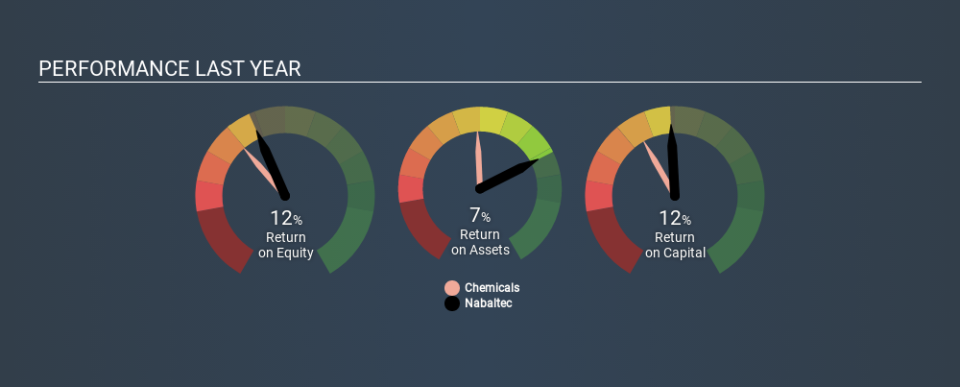Are Nabaltec AG’s (ETR:NTG) High Returns Really That Great?

Today we'll look at Nabaltec AG (ETR:NTG) and reflect on its potential as an investment. To be precise, we'll consider its Return On Capital Employed (ROCE), as that will inform our view of the quality of the business.
Firstly, we'll go over how we calculate ROCE. Second, we'll look at its ROCE compared to similar companies. Last but not least, we'll look at what impact its current liabilities have on its ROCE.
Return On Capital Employed (ROCE): What is it?
ROCE measures the 'return' (pre-tax profit) a company generates from capital employed in its business. All else being equal, a better business will have a higher ROCE. Overall, it is a valuable metric that has its flaws. Renowned investment researcher Michael Mauboussin has suggested that a high ROCE can indicate that 'one dollar invested in the company generates value of more than one dollar'.
How Do You Calculate Return On Capital Employed?
The formula for calculating the return on capital employed is:
Return on Capital Employed = Earnings Before Interest and Tax (EBIT) ÷ (Total Assets - Current Liabilities)
Or for Nabaltec:
0.12 = €21m ÷ (€240m - €56m) (Based on the trailing twelve months to September 2019.)
Therefore, Nabaltec has an ROCE of 12%.
Check out our latest analysis for Nabaltec
Does Nabaltec Have A Good ROCE?
ROCE is commonly used for comparing the performance of similar businesses. Using our data, we find that Nabaltec's ROCE is meaningfully better than the 7.1% average in the Chemicals industry. We consider this a positive sign, because it suggests it uses capital more efficiently than similar companies. Separate from Nabaltec's performance relative to its industry, its ROCE in absolute terms looks satisfactory, and it may be worth researching in more depth.
Our data shows that Nabaltec currently has an ROCE of 12%, compared to its ROCE of 8.4% 3 years ago. This makes us wonder if the company is improving. You can click on the image below to see (in greater detail) how Nabaltec's past growth compares to other companies.
When considering ROCE, bear in mind that it reflects the past and does not necessarily predict the future. Companies in cyclical industries can be difficult to understand using ROCE, as returns typically look high during boom times, and low during busts. ROCE is only a point-in-time measure. Future performance is what matters, and you can see analyst predictions in our free report on analyst forecasts for the company.
Nabaltec's Current Liabilities And Their Impact On Its ROCE
Current liabilities are short term bills and invoices that need to be paid in 12 months or less. Due to the way the ROCE equation works, having large bills due in the near term can make it look as though a company has less capital employed, and thus a higher ROCE than usual. To counteract this, we check if a company has high current liabilities, relative to its total assets.
Nabaltec has current liabilities of €56m and total assets of €240m. As a result, its current liabilities are equal to approximately 23% of its total assets. Low current liabilities are not boosting the ROCE too much.
Our Take On Nabaltec's ROCE
With that in mind, Nabaltec's ROCE appears pretty good. Nabaltec looks strong on this analysis, but there are plenty of other companies that could be a good opportunity . Here is a free list of companies growing earnings rapidly.
I will like Nabaltec better if I see some big insider buys. While we wait, check out this free list of growing companies with considerable, recent, insider buying.
If you spot an error that warrants correction, please contact the editor at editorial-team@simplywallst.com. This article by Simply Wall St is general in nature. It does not constitute a recommendation to buy or sell any stock, and does not take account of your objectives, or your financial situation. Simply Wall St has no position in the stocks mentioned.
We aim to bring you long-term focused research analysis driven by fundamental data. Note that our analysis may not factor in the latest price-sensitive company announcements or qualitative material. Thank you for reading.



